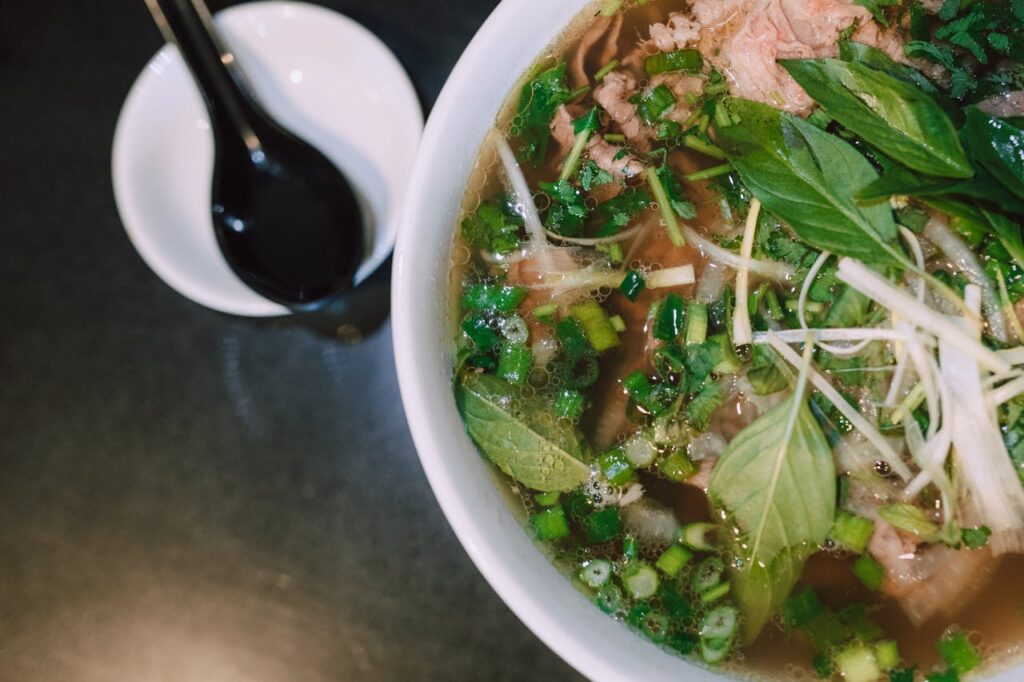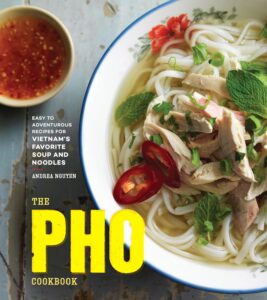Steam rises from the ceramic bowl, carrying with it the intoxicating aroma of star anise, cinnamon, and simmered beef bones. You lift the spoon to your lips, and suddenly the world feels right again. But what if I told you that this moment of pure comfort isn’t just feeding your soul—it’s actively healing your body?
Pho, Vietnam’s national dish, has been quietly working as nature’s medicine cabinet for centuries. While we’ve been slurping away in blissful ignorance, this humble bowl of soup has been delivering a powerhouse of nutrients, anti-inflammatory compounds, and healing properties that would make any nutritionist weep with joy.

The Bone Broth Foundation
At the heart of every authentic pho lies a broth that’s simmered for 12 to 24 hours—sometimes longer. This isn’t just about flavor; it’s about extracting every possible nutrient from those beef or chicken bones. When bones are slow-cooked for extended periods, they release a treasure trove of minerals and compounds that modern medicine is only beginning to fully appreciate.
Collagen and Gelatin: Your Skin’s Best Friends
The long cooking process breaks down collagen in the bones into gelatin, creating that satisfying, slightly thick consistency that coats your spoon. This isn’t just appealing to the palate—it’s revolutionary for your health. Collagen is the most abundant protein in your body, forming the structural foundation of your skin, joints, bones, and connective tissues.
As we age, our natural collagen production decreases by about 1% per year after age 20. The gelatin in pho broth provides the amino acids glycine, proline, and hydroxyproline—the building blocks your body needs to synthesize new collagen. Regular consumption can lead to improved skin elasticity, reduced joint pain, and stronger bones. It’s like drinking from the fountain of youth, one spoonful at a time.
Mineral Powerhouse
The bone broth in pho is exceptionally rich in essential minerals that are often difficult to obtain from other food sources. Calcium and phosphorus leach from the bones, supporting bone density and dental health. Magnesium, crucial for over 300 enzymatic reactions in your body, helps regulate blood pressure and supports muscle function. Potassium aids in maintaining proper fluid balance and heart rhythm.
Perhaps most importantly, the broth contains highly bioavailable forms of these minerals, meaning your body can absorb and utilize them more effectively than synthetic supplements.
Spices That Heal
The distinctive flavor profile of pho comes from a carefully orchestrated blend of spices, each bringing its own therapeutic properties to the bowl.
Star Anise: The Antiviral Warrior
Those beautiful eight-pointed stars floating in your broth aren’t just for show. Star anise contains shikimic acid, the primary ingredient in Tamiflu, one of the most widely used antiviral medications. This compound has been shown to inhibit viral replication and boost immune function. During cold and flu season, a bowl of pho might be exactly what your body needs to fight off infections naturally.
Cinnamon: The Blood Sugar Stabilizer
The sweet warmth of cinnamon in pho broth does more than please your taste buds. Studies have shown that cinnamon can help regulate blood sugar levels by improving insulin sensitivity. For people managing diabetes or prediabetes, incorporating cinnamon-rich foods like pho into their diet may help maintain more stable glucose levels throughout the day.
Ginger: The Digestive Healer
Fresh ginger, often added to pho broth or served as a garnish, is a powerful anti-inflammatory agent. Gingerol, its active compound, has been shown to reduce nausea, improve digestion, and decrease inflammation markers in the body. If you’ve ever noticed that pho settles your stomach after a heavy meal or helps when you’re feeling queasy, you can thank the ginger.
Cloves and Cardamom: Antioxidant Champions
These aromatic spices are among the highest sources of antioxidants in the culinary world. They help combat oxidative stress, which is linked to aging, heart disease, and various chronic conditions. The ORAC (Oxygen Radical Absorbance Capacity) values of these spices are off the charts, making your pho bowl a potent anti-aging elixir.
The Protein Powerhouse
The meat in pho—whether it’s tender slices of rare beef, slow-cooked brisket, or succulent chicken—provides high-quality complete protein containing all essential amino acids your body needs.
Muscle Maintenance and Growth
A typical bowl of pho contains 25-30 grams of protein, making it an excellent choice for muscle maintenance and growth. The amino acid profile is particularly rich in leucine, which triggers muscle protein synthesis. This makes pho an ideal post-workout meal or a satisfying option for older adults who need to maintain muscle mass.
Satiety and Weight Management
The combination of protein and the physical volume of the broth creates a powerful satiety signal. Research shows that soup-based meals tend to be more filling than equivalent calories consumed in solid form. The warm temperature also slows eating pace, giving your brain time to register fullness signals. For those managing their weight, pho offers satisfaction without excessive calories.
Rice Noodles
Pho’s rice noodles provide easily digestible carbohydrates that fuel your body without causing dramatic blood sugar spikes. Unlike wheat-based pasta, rice noodles are naturally gluten-free, making pho accessible to those with celiac disease or gluten sensitivity.
The moderate glycemic index of rice noodles means they provide sustained energy rather than the quick spike and crash associated with refined sugars. This makes pho an excellent choice for maintaining steady energy levels throughout the day.
Herbs and Vegetables
No bowl of pho is complete without its accompanying plate of fresh herbs and vegetables, each contributing unique health benefits:
Bean Sprouts: Enzyme Powerhouses
These crunchy additions are rich in enzymes that aid digestion and provide vitamin C, folate, and fiber. The sprouting process actually increases the nutritional content compared to the original bean, creating a concentrated source of vitamins and minerals.
Thai Basil: Anti-inflammatory Marvel
The peppery, licorice-scented Thai basil contains compounds like eugenol and rosmarinic acid, which have potent anti-inflammatory and antimicrobial properties. Regular consumption may help reduce inflammation markers and support immune function.
Cilantro: Heavy Metal Detoxifier
Love it or hate it, cilantro is a natural chelator, meaning it can help remove heavy metals from your body. It’s also rich in antioxidants and has been shown to have antimicrobial properties.
Lime: Vitamin C Boost
The fresh lime juice squeezed into pho provides a significant dose of vitamin C, essential for immune function, collagen synthesis, and iron absorption. The citric acid also helps your body absorb the minerals from the broth more effectively.
The Hydration Factor
In our chronically dehydrated society, the high water content of pho provides essential hydration while delivering nutrients. Unlike plain water, the electrolytes and minerals in pho broth help your body retain and utilize the fluids more effectively.
The warm temperature of the soup also promotes circulation and can help clear nasal congestion—a natural decongestant that’s particularly beneficial during cold season or for those suffering from allergies.
Mental Health Benefits
The psychological benefits of pho shouldn’t be overlooked. The ritual of eating pho—the careful assembly of herbs, the methodical slurping of noodles, the warming sensation—activates the parasympathetic nervous system, promoting relaxation and stress relief.
The amino acid glycine found abundantly in bone broth has calming effects on the brain and may improve sleep quality. Some people report feeling more relaxed and sleeping better after consuming bone broth regularly.
Anti-Inflammatory Properties
Chronic inflammation is at the root of many modern diseases, from heart disease to arthritis to certain cancers. Pho’s combination of anti-inflammatory ingredients creates a synergistic effect that may help combat this underlying cause of illness.
The omega-3 fatty acids from grass-fed beef, the anti-inflammatory compounds in the spices, and the glycine from bone broth all work together to reduce inflammatory markers in the body. Regular consumption of these anti-inflammatory foods may contribute to better long-term health outcomes.
Digestive Health
The gelatin in pho broth helps heal and seal the gut lining, which is crucial for overall health. A healthy gut lining prevents toxins and undigested food particles from entering the bloodstream, reducing inflammation and supporting immune function.
The warm, liquid nature of pho also makes it easy to digest, making it an excellent choice for people recovering from illness or those with sensitive digestive systems.
Medicine in a Bowl
The next time you find yourself craving pho, embrace it guilt-free. You’re not just indulging in comfort food—you’re nourishing your body with one of nature’s most complete healing foods. From the collagen-rich broth that supports your joints and skin to the anti-inflammatory spices that fight disease, every spoonful delivers targeted nutrition that your body craves.
In a world of processed foods and quick fixes, pho stands as a testament to the healing power of real, whole foods prepared with time and care. It’s proof that the most powerful medicine doesn’t always come in a bottle—sometimes it comes in a bowl, accompanied by the wisdom of generations and the simple pleasure of a perfectly balanced meal.
Hey there! We hope you love our fitness programs and the products we recommend. Just so you know, Symku Blog is reader-supported. When you buy through links on our site, we may earn an affiliate commission at no extra cost to you. It helps us keep the lights on. Thanks.
Disclaimer: The information provided in this discussion is for general informational and educational purposes only. It is not intended as medical or professional advice. Only a qualified health professional can determine what practices are suitable for your individual needs and abilities.


